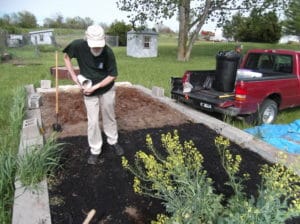By David Yarrow
Biochar can benefit your soil, but only if properly prepared prior to application. In November 2007, scientists at the USDA National Laboratory for Agriculture and the Environment (NLAE) in Ames, Iowa, began multi-year field trials to assess the effects of biochar on crop productivity and soil quality. Scientists amended almost 8 acres with biochar made from hardwood. Twelve plots received 4 tons per acre; 12 were treated with 8 tons per acre.
They found no significant difference in the three-year average grain yield from either treatment. Other USDA field and laboratory studies in Idaho, Kentucky, Minnesota, South Carolina, and Texas showed hardwood biochar can improve soil structure and increase sandy soils’ ability to retain water. But soil fertility response was more variable.
USDA scientists violated four key principles for biochar use: they used 1) bulk char, in one large load; 2) raw, uncharged char; 3) sterile, uninoculated char, with only a tad of microbial life; and 4) synthetic salt fertilizer, tillage, and other antibiotic practices.

Author David Yarrow helps install a biochar test plot at Subterra in Kansas.
Biochar, like water, is best added in a series of small doses so soil has adequate time to distribute and digest it. After all, soil may get 25 or more inches of rain a year, but not all at once in a single event. We already know from research in the Amazon that dumping 5, 10, or even 20 tons of raw char all at once into poor soil retards plant growth for one year and maybe two. After that, though, plants erupt in impressive, vigorous growth.
But a dip in yield isn’t acceptable for production agriculture. Farmers can’t wait a year or two to harvest a profitable crop. Professional growers need fast response and strong stimulus to growth. Economics and handling logistics require convenience and low cost, with vigorous growth from minimal applied material.
Fortunately, we are learning how to prepare char for optimum results in soil and on crops. Biochar research in America is hardly 10 years old, but solid research shows that properly prepared, intelligently applied biochar has dramatic effects on soil structure and plant growth at as little as 500 pounds per acre.
There are four fundamental steps for optimally preparing biochar for use in soil: moisten, mineralize, micronize, and microbial inoculation.
Biochar: Moisten
The first step is to add enough water to moisten char without it becoming waterlogged.
Fresh from a production burner, char is bone dry. It’s heated to over 500°C and hardly has a molecule of water in it. But water is the first ingredient to cook up biological life. Without water, even earthworms avoid char. When properly moistened, though, worms eat it and microbes rapidly move in to colonize it.

Holding a water rubber hose tube. Watering
Fresh char isn’t just dry — it’s hydrophobic. It actually resists water penetration. Residues of tar and resin left in the char are oily hydrocarbons that repel water. Until thin films and beads of tar are etched out of char, it won’t accept water.
However, char left lying on soil a few months loses those black beads of resin, and its color shifts from sparkly black to lusterless gray. Microbes inhabiting char see those hydrocarbon residues as food. Carbon chains and rings contain electrons and energy, so bacteria and other organisms eat it like candy.
Without water, char is very dusty. Fresh char is weak, brittle and shatters easily. Dry char easily sheds fine black dust that hovers around like a dark cloud. This dust is hard to handle, easily airborne, not healthy to inhale, and blows away in the wind. And yet, that very fine dust is the most precious part to add to soil because it most widely and intimately inserts itself between soil particles.
In normal production, water is used to kill the fire that makes the char — to cool it down and stop the charcoal fire. People beginning to make char are surprised how much water is needed to extinguish a charcoal fire. A lot of heat is held in char, and char’s micropores soak up lots of water. Engineers often quench fresh, hot char by dumping it in water. However, too much water yields char that is soggy, sticky, and heavy, which makes handling messy and sorting for particle size difficult. And waterlogged char is anaerobic, creating a poor habitat for beneficial microbes.
With careful attention and proper protocol, though, a minimum of water will put out a fire, yielding lightweight char that’s easy to process. With the right moisture, char is cohesive enough to hold together in soft clumps that are easy and safe to handle and don’t disappear in a wind. In this form it is able to build strong colonies of microbes and earthworms.
Biochar: Micronize
Smaller particles of biochar disappear into soil quicker, mixing more thoroughly and intimately with soil particles and organisms. Crushing, grinding, and screening char are thus valuable for increasing char’s dispersal throughout soil and optimizing its effects on soil structure, ion adsorption, and microbial colonization.
The first benefit of smaller particle size is increased surface area. For water ions and microbes to penetrate char, they must enter at an exterior surface. Smaller bits have more total surface available for absorption and adsorption. A one-inch chunk has a surface area of — at best — six square inches. The same chunk shattered in a thousand fragments has thousands times more surface area. Due to extremely fine microporosity, one gram of biochar has over 4,000 square feet of surface area, and 12,000 is achievable. Water, nutrients and microbes quickly penetrate smaller particles and access interior spaces.
Smaller particle sizes also distribute in soil more widely. Dust — the smallest particle, smaller than most soil particles — inserts itself between soil particles. Carbon isolates soil granules, insulating their electric charges. Thus, clay is less sticky, while sand has more cohesive body.
Smaller particles hold water better, because water penetrates more easily and quickly into char’s sponge-like micropores. Large chunks of char have difficulty drawing water into their deepest recesses, and do so slowly.
Similarly, smaller particles allow ions better penetration into the char’s sponge-like internal micropore matrix. A large chunk of char has difficulty drawing ions into its deepest interior spaces.
Ultimately, think like a microbe. What size micropores are fit for bacteria? What size will satisfy a fungi? Rice grain kernels of char are large enough to house thousands of microbes. A one-inch chunk of char is a microbial metropolis — millions of denizens inhabit and share such a charred carbon matrix.
Because char performs an assortment of services to soil, a variety of particle sizes seems to work best. Rice-grain size char is large enough for large microbial communities. Powdered char provides condominiums for microbes. Fine dust is most effective to separate soil particles and shift soil structure and tilth.
One advantage of weedy biomass is that its char easily crushes to dust in your hand. Minimal effort and machinery are needed to create extra fine, fluffy char, and such char seems to further enhance soil structure and boost its cation-exchange capacity (CEC) and anion-exchange capacity (AEC). After a few years of field trials, we may decide weedy char is better than woody for many agricultural soils and crops.
One fascinating aspect of biochar is water-soluble complex carbons. Tiny bits of char — the finest dust, with up to 100 carbons — are small and light enough to suspend in water. These extremely small carbon molecules can be harvested by rinsing fresh, dusty char with water. They disappear in water, making it slightly dark. These microparticles are useful in foliar and other sprays, where minerals ions and nutrients are packaged in ultra-light carbons. Such nutrients are more easily and efficiently assimilated through leaf pores. And inside a plant, the carbons strengthen plant structure and energy.
Biochar: Mineralize
The third step in proper biochar preparation is adding minerals to it. Soil is a battery that stores electric charge. Electrons and ions are electric charges that adsorp onto soil particles, especially soil organic matter and biochar. The ability of soils to capture and hold these charges — both positive (CEC) and negative (AEC) — creates a fundamental electric storage capacity, like the electric potential, or ampere-hours, of a battery. Beyond simple quantity, it’s important to also examine how soils can easily and quickly make these electric charges available to organisms.

Devin Gerling helps plant a biochar test plot in Kansas.
Both soil organic matter and biochar have remarkable capacity to gather and store both negative (electron) and positive (proton = H+) charges, and are highly efficient at holding and delivering ionized minerals and their electrons to cells.
Biochar’s high adsorption capacity makes it an ideal delivery system for minerals and their electric charges. Electrons and ions adsorped onto and into biochar are safely and efficiently placed in the root zone and kept there, ready for ion exchanges with plant roots. Char-adsorped minerals are removed from the soil solution, and thus have minimal mobility to leach and outgas. So biochar keeps any electrons in the root zone.
Micronized minerals that are finely powdered are more able to blend into and make contact with bits of char, and thus deliver electric charges where they are needed. Like micronized char, smaller particles mean greater surface area and faster, easier digestion by microbes. Stone meal or rock dusts are natural, insoluble forms of minerals that can be mixed with char to charge the soil battery. Synthetic soluble commercial fertilizers can also be micronized to blend into char to supply electric charge.
Most farm soils have deficits and/or imbalances of major minerals, and thus require amendments. Similarly, char made from biomass grown in mineral-deficient soil will be short of essential elements. Any soil test can quickly and cheaply reveal which minerals a soil needs and in what amounts. Adding these minerals to soil directly can create losses and lower effective use of the minerals. But blending these minerals with biochar adds needed nutrients in a high efficiency, targeted delivery system.
Nature’s best source for trace elements is sea minerals. For over a billion years, minerals from the land washed into the sea.
Every element that dissolves in water is in the sea — including nano- and pico-elements. Sea water is a full spectrum source for all elements that are essential for life. And sea minerals are in ratios that are ideal to sustain cells and organisms. This mix of minerals was blended, sorted, stirred, precipitated, titrated, and energized by geological and biological processes during Earth’s evolution.
Immediately after making char, douse the char with sea minerals dissolved in water. Adding this solution to fresh, hot char accomplishes five tasks in one operation:
1) Extinguishing: the sea mineral solution puts out the charcoal fire by cooling and by steam;
2) Moistening: hot char flushed with water generates steam with enough pressure to force itself into char micropores;
3) Fracturing: steam pressure is often strong enough to open cracks in char that increase its surface area, boosting adsorption;
4) Scouring: alkali ions of sea minerals loosen and remove tar and resin residues from char’s micropores;
5) Mineralizing: sea mineral ions adsorped onto char’s electric charge sites load it with a full menu of elements.
When microbes and roots invade properly mineralized char micropores, they find fundamental food that all cells require, already in solution, ready to feed them. This elemental feast gives soil a foundation of essential nutrients to support rapid, vigorous, healthy plant growth.
Biochar’s AEC also allows it to adsorp and supply negative ions, mostly nitrates and phosphates. Nitrogen and phosphorus were the number one and number two fertilizers in 20th century farming. Sea minerals don’t supply much of either, so N and P must be added in various forms. Biochar is a high-efficiency delivery system for anions, with high bioavailability and minimal loss by leaching. In properly prepared biochar, N and P are not only present as nutrients, but also as organic biomolecules of living soil biology. Microbes living in biochar are an ideal medium to retain and recycle these anions.
Biochar: Microbial Inoculation
The fourth step in preparing biochar for soil is to add life to it. With water, nutrient ions, and empty micropores in the char, microbes move in. We don’t eat our houses, and microbes don’t eat char. They live in it.
In the paradigm shift from 20th century chemistry to 21st century biology, the culture and care of symbiotic organisms is crucial for soil fertility. For endless eons of geological evolution, microbes managed and improved soil to sustain fertility. Creating fertile soil is a fundamental job description for these “no-see-ums” of soil. The least and smallest of all life forms are among the Earth’s most ancient communities. Yet we ignore what we can’t see — microbes — and focus on obvious, visible bulk ingredients — organic matter, compost, and mineral fertilizers.
Bacteria are Earth’s oldest life-forms. While a single bacteria is simple, as a collective community or culture they are complex, and more intelligent than plants. One expression of this is that it is primarily bacteria that consume trace elements and build them into complex biomolecules that perform key, often fundamental, metabolic and regulatory functions. If minerals are the foundation of biology, microbes are the sill plate where foundation meets superstructure. Microbes transform minerals into protoplasm in living cells. Bacteria are the primary consumers of mineral nutrients. They also synthesize critical biomolecules that more complex organisms require. For example, all B vitamins are synthesized by microbes, who then supply them to plants and animals.
Vitamin B12 — the so-called “vegetarian vitamin” — is not made by animals, but only by a bacteria. B12’s mineral cofactor, cobalt, has six valence electrons in outer orbitals, and thus makes six bonds to other atoms. B12 bacteria build a complex structure of carbon rings to enclose an atom of cobalt. Unlike chlorophyll and heme, whose carbon rings are in a two-dimensional flat disk, B12’s more complex carbon rings form a three-dimensional structure. Thus Cobalt’s magnetic energy is focused and harnessed to perform certain critical, universal energy exchange functions needed for DNA replication, hormone synthesis, and red blood cell formation.
These simplest and least of all life-forms digest trace elements to transform them into key biomolecules that are metabolic catalysts and regulators in larger organisms. Bacteria also assemble minerals and biomolecules into primary units of protoplasm, which are fed to cells of larger, more complex life-forms, including plants and animals.
Studies show that biochar is an ideal substrate to culture many beneficial microbes. Features that make char ideal for water filtration media also make it optimum habitat for the smallest microbes. Larger particles soak up nutrients and water. With essential nutrients abundant and bioavailable, microbes take up residence inside char. Each bit of biochar becomes a host for colonies of bacteria and fungi, whose presence anchors the rest of the soil biology.
Larger char particles provide enough space for large-scale, fully diversified microbial communities to become established, and nurse the growth of their food-seeking networks.
For example, mycorrhizal fungi take up residence in char, proliferate by abundant sporulation, send whisker-thin hyphae out into soil to search for water and nutrients, and pump them to fungi living in char. Char thus becomes an active storehouse to stockpile essential nutrients. Fungi interact with other organisms in symbiotic networks to create complex feeding webs. This interactive community helps soil breathe, absorb water, mobilize nutrients, and support larger life-forms.
This story was published in the July 2013 issue of Acres U.S.A. magazine. For more than 30 years David Yarrow has taught and organized about building sustainable food systems in the Northeast United States.

